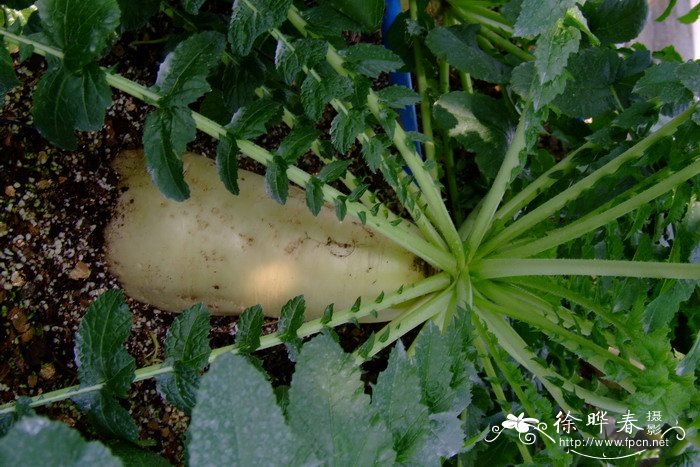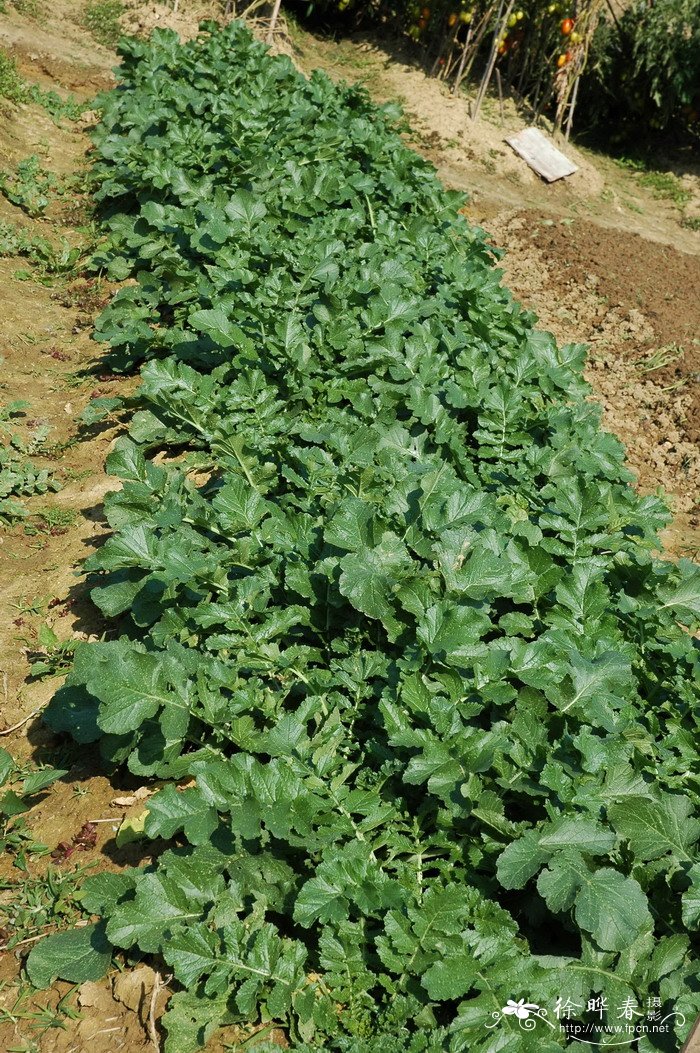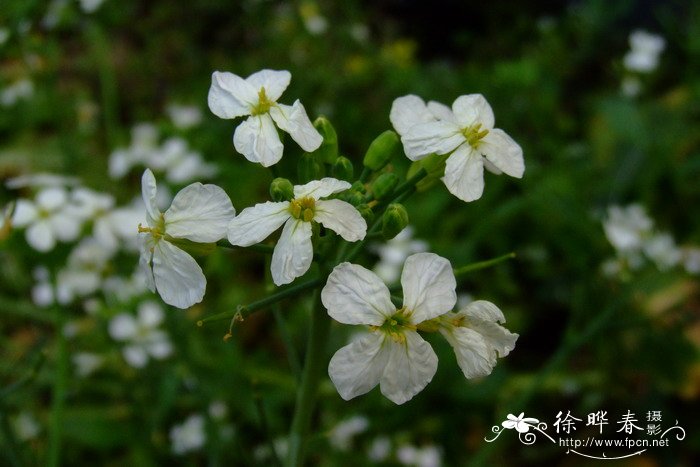萝卜Raphanus sativus
中文名(Chinese Name):萝卜
学名(Scientific Name):Raphanus sativus Linn.
英文名(English Common Name):
别名(Chinese Common Name):莱菔
异名(Synonym):Raphanus sativus var. raphanistroides (Makino) Makino Raphanus niger Mill. Raphanus acanthiformis J. M. Morel Raphanus sativus f. raphanistroides Makino Raphanus macropodus H. Lév. Raphanus sativus var. macropodus (H. Lév.) Makino Raphanus taquetti H. Lév. Raphanistrum gayanum Fisch. & C.A. Mey. Raphanus candidus Vorosch. Raphanus gayanus (Fisch. & C.A. Mey.) G. Don ex Sweet Raphanus taquetii H. Lév. Raphanus sativus var. radicula Pers. Raphanus acanthiformis var. raphanistroides (Makino) HARA
科属(Family & Genus):十字花科Cruciferae萝卜属Raphanus
形态特征(Description):二年或一年生草本,高20-100厘米;直根肉质,长圆形、球形或圆锥形,外皮绿色、白色或红色;茎有分枝,无毛,稍具粉霜。基生叶和下部茎生叶大头羽状半裂,长8-30厘米,宽3-5厘米,顶裂片卵形,侧裂片4-6对,长圆形,有钝齿,疏生粗毛,上部叶长圆形,有锯齿或近全缘。总状花序顶生及腋生;花白色或粉红色,直径1.5-2厘米;花梗长5-15毫米;萼片长圆形,长5-7毫米;花瓣倒卵形,长1-1.5厘米,具紫纹,下部有长5毫米的爪。长角果圆柱形,长3-6厘米,宽10-12毫米,在相当种子间处缢缩,并形成海绵质横隔;顶端喙长1-1.5厘米;果梗长1-1.5厘米。种子1-6个,卵形,微扁,长约3毫米,红棕色,有细网纹。花期4-5月,果期5-6月。
分布(Distribution):全国各地普遍栽培。
用途(Use):根作蔬菜食用;种子、鲜根、枯根、叶皆入药:种子消食化痰;鲜根止渴、助消化,枯根利二便;叶治初痢,并预防痢疾;种子榨油工业用及食用。
引自中国植物志英文版:FOC Vol. 8 Page 25
Raphanus sativus Linnaeus, Sp. Pl. 2: 669. 1753.
萝卜 luo bo | Brassicaceae | Raphanus
Raphanus acanthiformis J. M. Morel; R. chinensis Miller (1768), not (Linnaeus) Crantz (1769); R. macropodus H. Léveillé; R. niger Miller; R. raphanistroides (Makino) Nakai; R. raphanistrum Linnaeus var. sativus (Linnaeus) Domin; R. sativus var. macropodus (H. Léveillé) Makino; R. sativus f. raphanistroides Makino; R. sativus var. raphanistroides (Makino) Makino; R. taquetii H. Léveillé.
Herbs annual or biennial, 10-130 cm tall, glabrous, scabrous, or hispid. Roots fleshy, white, pink, red, or black, linear, fusiform, oblong, or globose, 1-100 × 0.5-45 cm, sometimes slender and not fleshy. Stems simple or branched. Basal leaves with petioles 1-30 cm; leaf blade oblong, obovate, oblanceolate, or spatulate in outline, 2-60 × 1-20 cm, lyrate or pinnatisect, sometimes undivided, margin dentate, apex obtuse or acute; lateral lobes 1-12 on each side of midvein, sometimes absent, oblong or ovate, to 10 × 5 cm. Uppermost cauline leaves subsessile, often undivided, dentate. Fruiting pedicels divaricate or ascending, straight, 0.5-4 cm. Sepals narrowly oblong, 5.5-10 × 1-2 mm, glabrous or sparsely pubescent. Petals purple, pink, or sometimes white, often with darker veins, broadly obovate, 1.2-2.2 cm × 3-8 mm, apex obtuse or emarginate; claw to 1.4 cm. Filaments slender, 5-12 mm; anthers 1.5-2 mm, sagittate at base. Fruit fusiform or lanceolate, sometimes ovoid or cylindric; seedless valvular segment 1-3.5 mm; seed-bearing distal segment (1-)3-15(-25) × (0.5-)0.7-1.3(-1.5) cm, corky, rounded at base, conical at apex, smooth or rarely slightly constricted between seeds, not ribbed; style 1-4 cm; stigma entire. Seeds globose or ovoid, 2.5-4 mm in diam. Fl. and fr. depending on cultivation time. 2n = 18*.
Fields, roadsides, waste areas. Throughout China [native to the Mediterranean region; cultivated worldwide].
Long cultivated in E Asia primarily as a vegetable and medicinal plant. A very variable species with regard to fleshy root color, shape, and size, plant height, degree of division and size of leaves, flower color, and fruit shape and size. Numerous infraspecific taxa have been recognized, and their taxonomy is controversial and highly confused. The interested reader should consult Pistrick (Kulturpflanze 35: 225-321. 1987). Perhaps the most interesting cultivar, which is grown primarily in China and Japan, is var. longipinnatus L. H. Bailey, with roots to 50 kg in weight and to 1 m in length and enormous rosettes to 2 m in diam.




(责任编辑:徐晔春)
学名(Scientific Name):Raphanus sativus Linn.
英文名(English Common Name):
别名(Chinese Common Name):莱菔
异名(Synonym):Raphanus sativus var. raphanistroides (Makino) Makino Raphanus niger Mill. Raphanus acanthiformis J. M. Morel Raphanus sativus f. raphanistroides Makino Raphanus macropodus H. Lév. Raphanus sativus var. macropodus (H. Lév.) Makino Raphanus taquetti H. Lév. Raphanistrum gayanum Fisch. & C.A. Mey. Raphanus candidus Vorosch. Raphanus gayanus (Fisch. & C.A. Mey.) G. Don ex Sweet Raphanus taquetii H. Lév. Raphanus sativus var. radicula Pers. Raphanus acanthiformis var. raphanistroides (Makino) HARA
科属(Family & Genus):十字花科Cruciferae萝卜属Raphanus
形态特征(Description):二年或一年生草本,高20-100厘米;直根肉质,长圆形、球形或圆锥形,外皮绿色、白色或红色;茎有分枝,无毛,稍具粉霜。基生叶和下部茎生叶大头羽状半裂,长8-30厘米,宽3-5厘米,顶裂片卵形,侧裂片4-6对,长圆形,有钝齿,疏生粗毛,上部叶长圆形,有锯齿或近全缘。总状花序顶生及腋生;花白色或粉红色,直径1.5-2厘米;花梗长5-15毫米;萼片长圆形,长5-7毫米;花瓣倒卵形,长1-1.5厘米,具紫纹,下部有长5毫米的爪。长角果圆柱形,长3-6厘米,宽10-12毫米,在相当种子间处缢缩,并形成海绵质横隔;顶端喙长1-1.5厘米;果梗长1-1.5厘米。种子1-6个,卵形,微扁,长约3毫米,红棕色,有细网纹。花期4-5月,果期5-6月。
分布(Distribution):全国各地普遍栽培。
用途(Use):根作蔬菜食用;种子、鲜根、枯根、叶皆入药:种子消食化痰;鲜根止渴、助消化,枯根利二便;叶治初痢,并预防痢疾;种子榨油工业用及食用。
引自中国植物志英文版:FOC Vol. 8 Page 25
Raphanus sativus Linnaeus, Sp. Pl. 2: 669. 1753.
萝卜 luo bo | Brassicaceae | Raphanus
Raphanus acanthiformis J. M. Morel; R. chinensis Miller (1768), not (Linnaeus) Crantz (1769); R. macropodus H. Léveillé; R. niger Miller; R. raphanistroides (Makino) Nakai; R. raphanistrum Linnaeus var. sativus (Linnaeus) Domin; R. sativus var. macropodus (H. Léveillé) Makino; R. sativus f. raphanistroides Makino; R. sativus var. raphanistroides (Makino) Makino; R. taquetii H. Léveillé.
Herbs annual or biennial, 10-130 cm tall, glabrous, scabrous, or hispid. Roots fleshy, white, pink, red, or black, linear, fusiform, oblong, or globose, 1-100 × 0.5-45 cm, sometimes slender and not fleshy. Stems simple or branched. Basal leaves with petioles 1-30 cm; leaf blade oblong, obovate, oblanceolate, or spatulate in outline, 2-60 × 1-20 cm, lyrate or pinnatisect, sometimes undivided, margin dentate, apex obtuse or acute; lateral lobes 1-12 on each side of midvein, sometimes absent, oblong or ovate, to 10 × 5 cm. Uppermost cauline leaves subsessile, often undivided, dentate. Fruiting pedicels divaricate or ascending, straight, 0.5-4 cm. Sepals narrowly oblong, 5.5-10 × 1-2 mm, glabrous or sparsely pubescent. Petals purple, pink, or sometimes white, often with darker veins, broadly obovate, 1.2-2.2 cm × 3-8 mm, apex obtuse or emarginate; claw to 1.4 cm. Filaments slender, 5-12 mm; anthers 1.5-2 mm, sagittate at base. Fruit fusiform or lanceolate, sometimes ovoid or cylindric; seedless valvular segment 1-3.5 mm; seed-bearing distal segment (1-)3-15(-25) × (0.5-)0.7-1.3(-1.5) cm, corky, rounded at base, conical at apex, smooth or rarely slightly constricted between seeds, not ribbed; style 1-4 cm; stigma entire. Seeds globose or ovoid, 2.5-4 mm in diam. Fl. and fr. depending on cultivation time. 2n = 18*.
Fields, roadsides, waste areas. Throughout China [native to the Mediterranean region; cultivated worldwide].
Long cultivated in E Asia primarily as a vegetable and medicinal plant. A very variable species with regard to fleshy root color, shape, and size, plant height, degree of division and size of leaves, flower color, and fruit shape and size. Numerous infraspecific taxa have been recognized, and their taxonomy is controversial and highly confused. The interested reader should consult Pistrick (Kulturpflanze 35: 225-321. 1987). Perhaps the most interesting cultivar, which is grown primarily in China and Japan, is var. longipinnatus L. H. Bailey, with roots to 50 kg in weight and to 1 m in length and enormous rosettes to 2 m in diam.
(责任编辑:徐晔春)
踩一下[5]

顶一下[13]